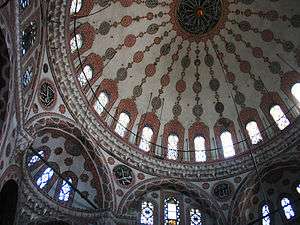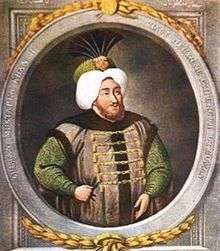Emetullah Rabia Gülnuş Sultan
| Emetullah Rabia Gülnûş Sultan | |||||
|---|---|---|---|---|---|
 | |||||
| Valide Sultan of the Ottoman Empire | |||||
| Tenure | 6 February 1695 – 6 November 1715 | ||||
| Predecessor | Saliha Dilaşub Sultan | ||||
| Successor | Saliha Sebkati Sultan | ||||
| Haseki Sultan of the Ottoman Empire | |||||
| Tenure | 5 July 1683 - 8 November 1687 | ||||
| Predecessor | Turhan Hatice Sultan | ||||
| Successor | Rabia Sultan | ||||
| Born |
Evmania Voria c. 1642 Rethymno, Crete, Republic of Venice | ||||
| Died |
6 November 1715 (aged 72-73) Constantinople, Ottoman Empire | ||||
| Burial | Yeni Valide Mosque | ||||
| Spouse | Mehmed IV | ||||
| Issue |
Mustafa II Ahmed III Hatice Sultan Fatma Sultan | ||||
| |||||
| House | House of Osman (by marriage) | ||||
| Religion | Islam, formerly Greek Orthodox | ||||
Emetullah Rabia Gülnuş Valide Sultan or Māhpāra Amatullāh Rābi'ā Gül-Nûş Valide Sultan (fully Devletlu İsmetlu Emetullah Rabia Gülnûş Valide Sultan Aliyyetü'ş-şân Hazretleri; 1642[1] – 6 November 1715) was Haseki Sultan of Ottoman Sultan Mehmed IV and Valide Sultan to their sons Mustafa II and Ahmed III.[2][3] She was the last imperial concubine to be legally married to an Ottoman Sultan.
Early life
Râbi'a Gülnûş was born in the town of Rethymno, Crete in 1642, when the island was under Venetian rule; she was originally named Eugenia Voria and she was an ethnic Greek, the daughter of a Greek Orthodox priest.[4][5][6][7][8][9][10][11] It has been theorized that her distant paternal ancestry lies in the Venetian Verzzizi family.[12]
Time as consort
The Ottoman army invaded the island during the Cretan War (1645–1669); she was captured as a very young girl when the Ottomans conquered Rethymno about 1646, she was taken as slave and was sent to Constantinople. She was renamed Mahpare (meaning "a slice of the moon") and was given a thoroughly Turkish and Muslim education in the harem department of Topkapi Palace and soon attracted the attention of the Sultan, Mehmed IV. He was famous for his hunting expeditions in the Balkans and used to take his favourite to these expeditions. They had two sons both of whom became the future Sultans, Mustafa II (born 1664; died 1703) and Ahmed III (born 1673; died 1736). Ahmed was born in Dobruca during one of the hunting expeditions of Mehmed IV. Her rivalry with Gülbeyaz, an odalisque of Mehmed IV led to a tragic end. Sultan Mehmed had been deeply enamored of her, but after Gülbeyaz entered his harem, his affections began to shift, Gülnuş, still in love with the sultan became madly jealous. One day, as Gülbeyaz was sitting on a rock and watching the sea, Gülnuş slightly pushed her off the cliff and drowned the young odalisque,[13][14][15][16] or according to others she ordered Gülbeyaz's strangulation in the Kandilli Palace. Some writers stress the fact that Gülnuş was a ruthless person claiming that she attempted to have her husband's brothers Suleiman II and Ahmed II strangled after she gave birth to her firstborn Mustafa, but that Mother Turhan Hatice Sultan had hindered these attempted murders.[17]
Valide Sultan
She became Valide in 1695 when her older son Mustafa II became the Sultan. She held the position during the reign of two sons. When Mustafa II was dethroned in 1703 the populace blamed Gülnuş, for his preference for Edirne over Constantinople as a place of residence and for the general confusion of life in the capital. She did have some political importance. In 1703, she was asked to confirm and approve of the succession of her other son, Ahmed III, to the throne, which she also did. Ahmed III thought it prudent to keep her out of sight until the feeling against her had died down. And, so on her return from Edirne, she went to the Old Palace for a time. She of course had more freedom of movement and contacts than the kadıns. Quite often she accompanied her son. She visited her daughters in their palaces, took part in the wedding of her daughter Fatma Sultan at the side of her son, visited her daughter Hatice Sultan in company of the sultan, after she had given birth to a daughter. She looked at parades, visited Eyüb, received the Grand vizier and the Şeyhüislam and accepted invitations by the Grand vizier and the Bostancıbaşı (with her son). She had hass (private domains) and a Kethüda (steward) who administered them for her. Mustafa kept close contacts with his mother, he honored her demonstratively whenever there was an occasion, he sent her information, asked for her well being and received many, many horses as gifts from her. He even prohibited that anybody should stay in a house in Çorlu, between Constantinople and Edirne, in which his mother had spent a night.
She is also attributed to having advised her son to the war with Russia in 1711. In 1709, king Charles XII of Sweden settled in Bender within the Ottoman Empire during his war with Russia. He wished the sultan to declare war against Russia and form an alliance with Sweden. The sultan was rumoured to listen to the advice of his mother, who had a large influence over him. Charles sent Stanislaw Poniatowski and Thomas Funck as his messengers.[20] They bribed a convert named Goin, formerly a Frenchman, who worked as a doctor in the palace. Goin arranged a meeting with the personal slave of the Valide, a Jewish woman, who they gave a personal letter to the Valide.[20] They were also introduced to the Hungarian eunuch Horwath, who became their propaganda person in the harem. The Valide became intrigued by Charles, took an interest in his cause, and even corresponded with him in Bender.[20] On 9 February 1711, Turkey declared war against Russia, as the sultan had been advised to by his mother, who convinced him that Charles was a man worth taking a risk for.
Death

For 20 years, she was the influential Valide Sultan. She died on 1715 in Edirne during the reign of her son Ahmed III just before the start of the era of prosperity and peace called the Tulip (Lâle) Era by the Turkish historians. She is buried at a tomb that is open to sky, that is near the mosque she bequeathed to be built at Üsküdar on the Anatolian side of Istanbul, called the Yeni Valide Mosque.
See also
- Ottoman Empire
- Ottoman dynasty
- Ottoman family tree
- List of Valide Sultans
- List of sultans of the Ottoman Empire
- Line of succession to the Ottoman throne
- Ottoman Emperors family tree (simplified)
- List of consorts of the Ottoman Sultans
References
- ↑ Verlag, K.G. Saur – Çıkar, Jutta R. M. (2004). Türkischer biographischer Index. Saur. p. 417. ISBN 3-598-34296-9.
Rabia Gülnus; Emetullah Rabia Gülnûş Sultan as wefl (c. 1642 (1052) - 6 November 1715)
- ↑ "Sultan II. Mustafa Han". Republic of Turkey Ministry of Culture and Tourism. Archived from the original on August 13, 2014. Retrieved 2009-02-06.
- ↑ "Sultan III. Ahmed Han". Republic of Turkey Ministry of Culture and Tourism. Archived from the original on August 13, 2014. Retrieved 2009-02-06.
- ↑ Baker, Anthony E (1993). The Bosphorus. Redhouse Press. p. 146. ISBN 975-413-062-0.
The Valide Sultan was born Evmania Voria, daughter of a Greek priest in a village near Rethymnon on Crete. She was captured by the Turks when they took Rethymnon in 1645.
- ↑ Freely, John (1996). Istanbul: the imperial city. Viking. p. 242. ISBN 0-14-024461-1.
Rabia Gulnus a Greek girl who had been captured in the Ottoman invasion of Crete. Râbi'a Gülnûş was the mother of Mehmet’s first two sons, the future sultans Mustafa II and Ahmet III.
- ↑ Bromley, J. S. (1957). The New Cambridge Modern History. University of California: University Press. p. 554. ISBN 0-521-22128-5.
the mother of Mustafa II and Ahmed III was a Cretan.
- ↑ Library Information and Research Service (2005). The Middle East. Library Information and Research Service. p. 91.
She was the daughter of a Cretan (Greek) family and she was the mother of Mustafa II (1664–1703), and Ahmed III (1673–1736).
- ↑ Thys-Şenocak, Lucienne (2006). Ottoman women builders. Ashgate. p. 46. ISBN 0-7546-3310-1.
The sultan appears to have been in no hurry to leave his prized concubine from the Ottoman conquest of Rethymnon, Crete – the haseki Emetullah Gulnus, and their new son Mustafa.
- ↑ Buturović, Amila; Schick, İrvin Cemil (2007). Women in the Ottoman Balkans: gender, culture and history. I.B.Tauris. p. 24. ISBN 1-84511-505-8.
Mahpeikir [Kösem Mahpeyker] and Revia Gülnûş [Rabia Gülnûş] were Greek.
- ↑ Freely, John (2000). Inside the Seraglio: private lives of the sultans in Istanbul. Penguin. p. 163.
Mehmet had by now set up his own harem, which he took with him in his peregrinations between Topkapi Sarayi and Edirne Sarayi. His favourite was Rabia Gülnûş Ummetüllah, a Greek girl from Rethymnon.
- ↑ Freely, John (2001). The lost Messiah. Viking. p. 132. ISBN 0-670-88675-0.
He set up his harem there, his favourite being Rabia Giilniis Ummetiillah, a Greek girl from Rethymnon on Crete.
- ↑ However some Turkish sources state that she was of Venetian origin. According to authoritative Turkish history books on lives of sultans, Emetullah Rabia Gülniş Sultan was of a Venetian family called Verzini which was settled in the city of Resmo (Turkish name for Rethymnon ). An example is Sakaoglu, Necdet (1999). Bu Mülkün Sultanlari. Oglak. pp. 303, 315. ISBN 975-329-299-6.
His mother was harem girl Rabia Gulniş who was of Venetian Verzini family settled in the city of Resmo in Crete.
- ↑ Narodna biblioteka "Sv. sv. Kiril i Metodiĭ. Orientalski otdel, International Centre for Minority Studies and Intercultural Relations, Research Centre for Islamic History, Art, and Culture (2003). Inventory of Ottoman Turkish documents about Waqf preserved in the Oriental Department at the St. St. Cyril and Methodius National Library: Registers, Volume 1 of Inventory of Ottoman Turkish Documents about Waqf Preserved in the Oriental Department at the St. St. Cyril and Methodius National Library, Rumen Kovachev. Narodna biblioteka "Sv. sv. Kiril i Metodiĭ.
- ↑ FATEMA MERNISSI (2013). Nasci num Harém. Leya. ISBN 978-9-892-32324-4.
- ↑ Fatema Mernissi (2011). The harem and the West, New storytellers. Giunti Editore. ISBN 978-8-809-76641-9.
- ↑ Jennifer Harding (2009). Emotions: a cultural studies reader. Routledge. ISBN 978-0-415-46930-2.
- ↑ Necdet Sakaoğlu (2007). Famous Ottoman women. Avea. p. 155.
rumor that Gulnus ordered the strangulation of Sultan's favorite concubine Gulbeyaz in Kandilli Palace, as a fact, in his book 'Kadmlar Saltanati'. Some writers stress the fact that Gulnus was a ruthless person claiming that she attempted to have her husband's brothers Suleyman and Ahmed strangled after she gave birth to her firstborn Mustafa, but that Mother Sultan Turhan had hindered these attempted murders.
- ↑ Sakaoğlu, Necdet (2008). Bu mülkün kadın sultanları: Vâlide sultanlar, hâtunlar, hasekiler, kadınefendiler, sultanefendiler. p. 285. ISBN 978-9-753-29623-6..
- ↑ Sakaoğlu, Necdet (2008). Bu mülkün kadın sultanları: Vâlide sultanlar, hâtunlar, hasekiler, kadınefendiler, sultanefendiler. pp. 266–269. ISBN 978-9-753-29623-6..
- 1 2 3 Herman Lindquist (in Swedish): Historian om Sverige. Storhet och Fall. (History of Sweden. Greatness and fall) 91-7263-092-2 (2000) Nordstedts förlag, Stockholm
| Ottoman royalty | ||
|---|---|---|
| Preceded by Turhan Hatice Sultan |
Haseki Sultan 5 July 1683 – 8 November 1687 |
Succeeded by Rabia Sultan |
| Preceded by Saliha Dilaşub Sultan |
Valide Sultan 6 February 1695 – 6 November 1715 |
Succeeded by Saliha Sultan |

